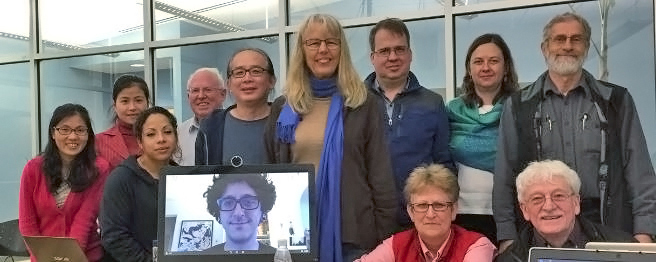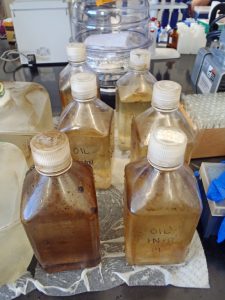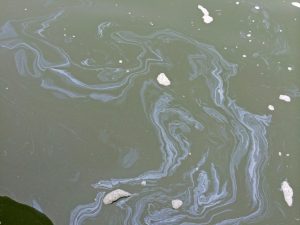Understanding Influences on Microbial Responses to Oil Spills
– March 10, 2015
ADDOMEx studies microbial biofilms’ impacts on oil and dispersants
What causes different responses in marine microbes to an oil spill? Opportunistic organisms readily degrade hydrocarbons from thousands of small leaks in the Gulf, some natural and others from oil and gas operations. However, after the Deepwater Horizon oil spill, scientists observed a range of different microbial responses – from helping dispersion to accumulating particles in marine snow. The Gulf of Mexico Research Initiative recently awarded the ADDOMEx consortium a grant to improve our understanding about influences on microbial responses to oil and dispersants and their subsequent fate.
ADDOMEx Director Antonietta Quigg with Texas A&M University at Galveston shared some thoughts about their consortium’s project that will examine interactions between oil, dispersants, and microbes. This information can inform risk assessment, interventions, and response plans for future oil spills.
“Hydrocarbons from a spill trigger a cascade of microbial responses from not only a single species but also a complex microorganism pool. Our systematic approach to studying microbial responses to oil and dispersants will help us develop models and predictive tools so that we will be able to say, ‘When oil and microbes get together, these are the kinds of things that can happen. When Corexit or other dispersants are added, this is how the relationship changes.’”
ADDOMEx stands for Aggregation and Degradation of Dispersants and Oil by Microbial Exopolymers. The ADDOMEx consortium will investigate the relationship between oil and dispersant fate and the microbial community under various environmental conditions. More specifically, Quigg explains that they want to understand how the presence of hydrocarbons trigger microbes to produce biofilms called exopolymeric substances (EPS). Microbes excrete EPS, which are made of proteins and carbohydrates, for protection from the oil or to emulsify the oil or both, thereby altering the oil’s fate.
“Depending on the species and what they encounter, microbes can modify their biofilm output. They can break down oil so that it’s no longer harmful, or they can stick to oil and sink with it to the sediment. They can attach to each other’s biofilms, creating a protective community shield with microbes on the inside protected to a greater degree than the ones on the outside. The microbes are clever in creating a very simple strategy that best protects them.”
The ADDOMEx investigators will conduct a series of consecutive experiments. Small-scale lab findings on bacterial and phytoplankton responses to oil and dispersants will inform larger-scale experiments that will test the impact of environmental conditions (temperature, salinity, nutrient status, seed particles) on microbial response. They will determine which microbes are producing EPS in response to oil, the mechanisms by which EPS aids in oil aggregation and/or dispersion, how oil-degrading microbes respond to dispersants, and how dispersants affect the resulting oil-dispersant-EPS system.
In the first experiments, researchers will monitor bacterial and phytoplankton growth and EPS production when exposed to different combinations of oil and dispersants and environmental stressors.
“In microchip experiments, we will grow microbes in a controlled lab setting. After exposing microbes to oil and Corexit, we will examine genomic-level responses, genes that get turned on and off, and then look at molecular-level responses to these toxic materials. Then we will examine at a more broad physiological level to observe if microbes grow slower, faster, or make different compounds, and if so, how does that protect them or enable them to survive in this toxic environment.”
The findings of the first experiments will feed into the roller table experiments. Researchers will use cultured bacteria and phytoplankton as well as native microbial populations from field-collected samples to study EPS production under selected conditions.
“The roller tables simulate natural turbulent conditions so that an organic kind of EPS or biofilm is developed. Then we can look at that material and see if it is the same kind of material that microbes developed in the controlled lab experiments. Rolling tanks permit aggregate formation, so we will also observe specific processes related to that and the role of EPS for aggregation or dispersion of oil and Corexit.”
Researchers will then conduct mesocosm experiments using carefully-chosen variables based on results from the first two experiments. Using seawater and particles collected from the Gulf of Mexico, researchers will measure EPS produced by a complex natural microbial community and examine their interactions with oil and dispersants combined with environmental factors.
“In the mesocosm studies, we are interested in community-level effects and responses. For example, diatoms are very important as a food source for zooplankton and higher trophic animals. If the diatom community shifts or is lost, there may be consequences at the higher trophic levels. There is reason to believe there will be a community effect because microbes excrete chemicals when threatened or stressed. Will these stressed communities work together or kill each other? Will they glue together regardless of species present? We’ll examine the actual community response and use that to predict possible impacts to higher trophic levels.”
ADDOMEx will develop a process-based understanding of the role that microbial exudates play in oil spill fate through degradation, dispersion, aggregation, or sedimentation and, in addition, how Corexit affects these processes. Their findings will establish a model that researchers can adjust for various combinations of oil, dispersants, and environmental factors and predict microbial behavior.
To help grow the next generation of multi-disciplinary Gulf of Mexico science experts, the ADDOMEx consortium will have a lab exchange program. Quigg likens their research interactions to assembling a puzzle, where different groups work on pieces that, together, answers questions. She explains how the exchange program facilitates the process.
“If you don’t understand how the puzzle parts go together, it’s very hard to plan actions and synthesize findings. In the lab exchange, young researchers can immerse themselves in work at other labs for a few weeks or months. Then they can really get a handle on what others do and their challenges. They come back with new insights and understanding, seeing things with fresh eyes. It’s difficult to teach or talk about conducting interdisciplinary research – young scientists need to experience it.”
The ADDOMEx consortium includes Texas A&M University at Galveston, Texas A&M University, the University of California – Merced, Mount Allison University, Old Dominion University, University of California Santa Barbara, University of Southern California, and the Texas Sea Grant.
For more ADDOMEx program and people information, click here.

The ADDOMEx research team January 2015. From left to right: Saijin Zhang, Chen Xu, Marcella Nunez, Patrick Hatcher, Wei-Chun Chin, Jason Sylvan (on screen), Uta Passow, Andrew Irwin, Kathy Schwehr, Antonietta Quigg (lead), Peter Santschi, Terry Wade and Zoe Finkel
************
The Gulf of Mexico Research Initiative (GoMRI) is a 10-year independent research program established to study the effect, and the potential associated impact, of hydrocarbon releases on the environment and public health, as well as to develop improved spill mitigation, oil detection, characterization and remediation technologies. An independent and academic 20-member Research Board makes the funding and research direction decisions to ensure the intellectual quality, effectiveness and academic independence of the GoMRI research. All research data, findings and publications will be made publicly available. The program was established through a $500 million financial commitment from BP. For more information, visit https://gulfresearchinitiative.org/.
© Copyright 2010- 2017 Gulf of Mexico Research Initiative (GoMRI) – All Rights Reserved. Redistribution is encouraged with acknowledgement to the Gulf of Mexico Research Initiative (GoMRI). Please credit images and/or videos as done in each article. Questions? Contact web-content editor Nilde “Maggie” Dannreuther, Northern Gulf Institute, Mississippi State University (maggied@ngi.msstate.edu).







